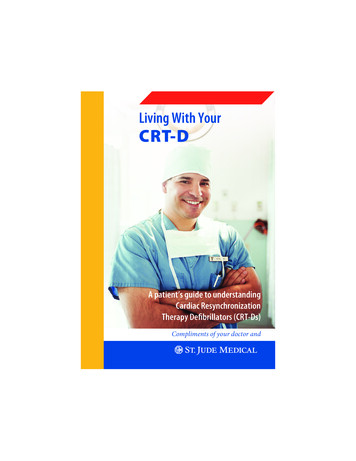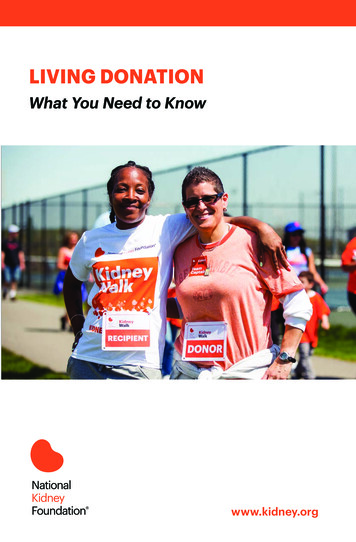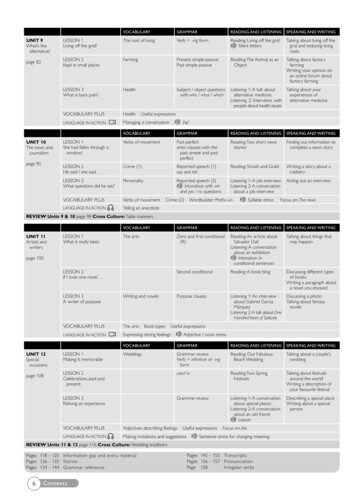
Transcription
Living With YourCRT-DA patient’s guide to understandingCardiac ResynchronizationTherapy Defibrillators (CRT-Ds)Compliments of your doctor and1
St. Jude Medical thanks James G. Porterfield, M.D., andLinda M. Porterfield, Ph.D., Arrhythmia Consultants,Methodist Central Hospital and University of Tennessee,Memphis, for their contribution to this booklet, parts ofwhich are based on their interactive computer-diskprogram, Know Your Defibrillator.
Your Contact and Device InformationHave your doctor or nurse complete the information onthese pages before you go home from the hospital.Physician NamePhone NumberAddressHospital NamePhone NumberAddressDevice Model NumberSerial NumberDate ImplantedDescription
Physician Instructions
Living With Your DeviceMany people suffer from heart disease. Often it takes theform of a rapid heartbeat that can result in a stopping ofthe normal pumping action of the heart (cardiac arrest).This kind of heartbeat is called an arrhythmia (a RITH meuh).There are also some patients who have congestive heartfailure or heart failure. Heart failure is a medical conditionin which the heart muscle is weakened and can no longerpump blood as efficiently as a healthy heart.Your doctor has explained that you have an arrhythmiaand heart failure.There are several ways to treat arrhythmias and heartfailure. This booklet is about one of the treatments,implantation of a device called a cardiac resynchronizationtherapy defibrillator (CRT-D).Implantable cardioverter-defibrillators (ICDs) look a lotlike pacemakers. As you may already know, pacemakerscan speed up a slow heartbeat. ICDs do just the opposite.They slow down a too-rapid heartbeat. Some ICDs can doboth. A CRT-D is an ICD that includes a pacing feature tohelp resynchronize (coordinate) the lower heart chambers,enabling your heart to beat efficiently.When you have a CRT-D, there are certain things youneed to know about.
Caution: Electromagnetic interference (EMI) mayinterfere with the function of your CRT-D. Avoid sourcesof electromagnetic fields. (Page 26)Caution: Metal detectors and Electronic Article Surveillance (EAS) systems will not harm your CRT-D if youpass through the archway at a normal pace. Avoid lingering in the immediate area. If a search with a hand heldwand is performed you should stress to security personnelthat the search should be performed quickly and that theyshould avoid holding the wand over your CRT-D for aprolonged period. (Page 28)Caution: Medical equipment, such as diathermy, TENsunits, and MRI may affect the function of your device.Always tell the doctor or nurse that you have a CRT-Dbefore undergoing any medical procedure. (Page 29)Caution: Keep a hand-held personal cellular phone atleast 6 inches (15 cm) from your CRT-D. A cellular phonemay affect the function of your device. (Page 32)Detailed information is provided in Cautions andWarnings beginning on page 26 of this booklet.CRT-Ds protect the lives of many people worldwide. Youand your doctor may decide to use a CRT-D in yourtreatment. We at St. Jude Medical want you to feel comfortable about your decision, so we have provided youwith this guide. It will help you understand how CRT-Dswork and how they will affect your life.
You will probably have questions that this booklet does notanswer. We encourage you to discuss them with yourdoctor and your nurse. They are your partners in healthcare and your best source of information.If you come across a word you do not understand, you canfind its definition in the Glossary on page 46.
Table of ContentsYour Contact and Device Information . . . . . . . . . . . . . 1Physician Instructions . . . . . . . . . . . . . . . . . . . . . . . . . . . 2Living With Your Device . . . . . . . . . . . . . . . . . . . . . . . . . . 1The Healthy Heart . . . . . . . . . . . . . . . . . . . . . . . . . . . . . . . 1Why is the heart sometimes called a “pump”? . . 1What does the heart look like? . . . . . . . . . . . . . . . 1How often does the heart beat? . . . . . . . . . . . . . . 2What is the AV Node? . . . . . . . . . . . . . . . . . . . . . . 3Arrhythmias . . . . . . . . . . . . . . . . . . . . . . . . . . . . . . . . . . . . 4What is an arrhythmia? . . . . . . . . . . . . . . . . . . . . 4What are some of the different kinds ofarrhythmias? . . . . . . . . . . . . . . . . . . . . . . . . . . . . . 4Heart Failure . . . . . . . . . . . . . . . . . . . . . . . . . . . . . . . . . . . . 9What is heart failure? . . . . . . . . . . . . . . . . . . . . . . 9What is congestive heart failure? . . . . . . . . . . . . . 9Some Basic Facts About CRT-Ds . . . . . . . . . . . . . . . . . 10What is a CRT-D? . . . . . . . . . . . . . . . . . . . . . . . . 10i
What does a CRT-D do? . . . . . . . . . . . . . . . . . . . 11Why do I need a CRT-D? . . . . . . . . . . . . . . . . . . 12Who does not need a CRT-D? . . . . . . . . . . . . . . 13What is the therapy like? . . . . . . . . . . . . . . . . . . 13How often does the CRT-D deliver therapy? . . . 13What should I do if I receive a shock? . . . . . . . . 14What happens after the CRT-D is implanted? . 15Why does my CRT-D vibrate? . . . . . . . . . . . . . . 17What happens when the battery runs down? . . 17What happens if a lead needs to be replaced? . . 17Risks and Benefits . . . . . . . . . . . . . . . . . . . . . . . . . . . . . . 18What are the benefits of having a CRT-D? . . . . 18What are the risks of having a CRT-D? . . . . . . . 18Implanting the CRT-D System . . . . . . . . . . . . . . . . . . . 20What will the operation be like? . . . . . . . . . . . . 20What are the most common types of surgery usedto implant the leads? . . . . . . . . . . . . . . . . . . . . . . 21What is recovery like? . . . . . . . . . . . . . . . . . . . . . 22Home From the Hospital . . . . . . . . . . . . . . . . . . . . . . . . 24Cautions and Warnings . . . . . . . . . . . . . . . . . . . . . . . . . 26General Information . . . . . . . . . . . . . . . . . . . . . . 26ii
EMI . . . . . . . . . . . . . . . . . . . . . . . . . . . . . . . . . . . 26Home Appliances . . . . . . . . . . . . . . . . . . . . . . . . 27Office Equipment . . . . . . . . . . . . . . . . . . . . . . . . 28Security Systems . . . . . . . . . . . . . . . . . . . . . . . . . 28Industrial Equipment . . . . . . . . . . . . . . . . . . . . . 29Medical Equipment . . . . . . . . . . . . . . . . . . . . . . . 29Recreation . . . . . . . . . . . . . . . . . . . . . . . . . . . . . . 30Arc Welding . . . . . . . . . . . . . . . . . . . . . . . . . . . . . 30Cellular phone . . . . . . . . . . . . . . . . . . . . . . . . . . . 32Learning to Live with Heart Disease . . . . . . . . . . . . . 34My illness has changed my life. How do I cope withit? . . . . . . . . . . . . . . . . . . . . . . . . . . . . . . . . . . . . . 34My spouse/family member is the patient. How canI help? . . . . . . . . . . . . . . . . . . . . . . . . . . . . . . . . . . 35Drugs . . . . . . . . . . . . . . . . . . . . . . . . . . . . . . . . . . . . . . . . . 36Why do I need medication if I have a CRT-D? . 36I’m told that my drugs may need periodicadjustments. How will that be done? . . . . . . . . . 36Is it OK to take my anti-arrhythmia and heartfailure drugs with other drugs? . . . . . . . . . . . . . 37Food and Nutrition . . . . . . . . . . . . . . . . . . . . . . . . . . . . . 38I already have heart disease. Will changing mydiet benefit me? . . . . . . . . . . . . . . . . . . . . . . . . . . 38iii
What are good sources of fiber? . . . . . . . . . . . . . 38How much fat can I have? . . . . . . . . . . . . . . . . . 38What is the best way to control my fat intake? . 39What foods are high in sodium? . . . . . . . . . . . . 39Besides diet, what affects heart health? . . . . . . . 40Why is being overweight dangerous for a personwith heart disease? . . . . . . . . . . . . . . . . . . . . . . . 40Exercise . . . . . . . . . . . . . . . . . . . . . . . . . . . . . . . . . . . . . . . 41What kind of exercise can I do after surgery? . . 41What is cardiac rehabilitation? . . . . . . . . . . . . . 41Do I need to go to a special facility for cardiacrehabilitation? . . . . . . . . . . . . . . . . . . . . . . . . . . . 42What if my CRT-D delivers therapy when Iexercise? . . . . . . . . . . . . . . . . . . . . . . . . . . . . . . . . 42What about sex? . . . . . . . . . . . . . . . . . . . . . . . . . . . . . . . 44How will having a CRT-D affect my sex life? . . 44Is there any chance the CRT-D will deliver therapyduring sex? . . . . . . . . . . . . . . . . . . . . . . . . . . . . . . 44Will I have problems with my sexual performance?44Is it possible to dislodge the CRT-D? Will pressureaffect its operation? . . . . . . . . . . . . . . . . . . . . . . . 45iv
Glossary of Terms . . . . . . . . . . . . . . . . . . . . . . . . . . . . . . 46Index . . . . . . . . . . . . . . . . . . . . . . . . . . . . . . . . . . . . . . . . . . 51v
vi
The Healthy HeartWhy is the heart sometimes called a “pump”?The heart’s job is to move blood around the body. Bloodcontains the oxygen that the organs and tissues need to dotheir work. The blood cells pick up oxygen in the lungsand the pumping action of the heart moves this oxygenrich blood to the rest of the body.What does the heart look like?As shown in Figure 1, the heart has four chambers. Whenit is at rest, the chambers fill with blood. With eachheartbeat, the heart squeezes blood out into the cleFigure 1. A typical heart.1
How often does the heart beat?A normal heart beats 60 to 100 times each minute.When you exercise, get excited, or experience stress, yourbody needs more oxygen. Your heart beats faster to keepup with the demand. How fast it beats is controlled by asmall area in the upper chamber of your heart. This area iscalled the sinoatrial (SA) node. It sends out an electricalsignal that causes your heart to beat. Figure 2 shows thelocation of the SA node.SANodeFigure 2. The sinoatrial (SA) node sends out an electricalsignal that causes your heart to beat.2
What is the AV Node?The atrioventricular (AV) node is another specialized areain the heart, located between the upper and lowerchambers of your heart. It holds the electrical signal fromthe SA node for a fraction of a second before releasing itinto the ventricle. The result is that the atrium beats first,pushing blood into the ventricle, and then the ventriclebeats after it has been filled with the blood from theatrium. Figure 3 shows the location of the AV node.AV NodeFigure 3. The atrioventricular (AV) node holds theelectrical signal from the SA node for a fraction of a secondbefore releasing it into the ventricle.3
ArrhythmiasWhat is an arrhythmia?An arrhythmia is any heart rhythm that is “abnormal.” Itmay be considered abnormal if it is too fast, too slow orstarts somewhere in the heart other than the SA node.What are some of the different kinds of arrhythmias?Some common arrhythmias are described below.BradycardiaDamage to the SA node or blockage of its electrical signalcan cause the heart to beat too slowly. This is called bradycardia. A person with bradycardia may feel very tiredbecause their body is not getting enough oxygen. Theymay also feel light-headed or dizzy. Pacemakers correctbradycardia by speeding up the heartbeat to a morenormal rate.4
Ventricular TachycardiaSometimes the heart beats much too fast. This is a seriouscondition called ventricular tachycardia (VT). As shownin Figure 4, VT is caused by signals that come from theheart’s lower chamber instead of from the SA node.During VT, the heart beats so fast that its chambers cannot completely fill with blood between beats. Therefore,less blood and oxygen are pumped through the body,causing dizziness, fainting, or loss of consciousness.Doctors and paramedics can stop VT with medication orwith an electrical shock. Sometimes the heart’s normal ratereturns without treatment.SANodeFigure 4. Ventricular tachycardia (VT) is caused by signalsthat come from the heart’s lower chamber instead of fromthe SA node.5
Ventricular FibrillationThe most serious kind of arrhythmia is ventricular fibrillation (VF). As Figure 5 illustrates, during VF many, manyelectrical signals come from the heart’s lower chambers.These signals cause the heart to “quiver” rather than beatnormally. Because of the quivering, very little blood ispumped out to the body. A person suffering from VF losesconsciousness very quickly. An electrical shock must begiven at once to restore normal heart rhythm. This can bedone by a CRT-D or an external defibrillator. Untreatedventricular fibrillation can be fatal.Figure 5. Ventricular fibrillation (VF) is caused by manyelectrical signals that come from the heart’s lowerchambers and cause the heart to quiver.6
Atrial FibrillationAtrial fibrillation is the most common arrhythmia in olderpeople. As Figure 6 illustrates, many electrical signals aresent from the upper chambers to the lower chambers in anirregular fashion. Some people may not feel any effects ofatrial fibrillation. But in many people, this arrhythmiacauses a feeling of pounding or fluttering in the chest. Itmay make people feel tired, sluggish, dizzy, or short ofbreath.More serious is the fact that atrial fibrillation can cause ablood clot inside the heart that can flow to any part of thebody, where it can cause a stroke or an embolism.Atrial fibrillation is normally treated with medicationsand/or electrical cardioversion at a hospital. If theseoptions do not adequately control the atrial fibrillation,then surgery or AV node ablation with the implantation ofa CRT-D or pacemaker may be used to assist in the controlof symptoms.7
Figure 6. Atrial fibrillation is caused by many electricalsignals that come from the heart’s upper chambers.8
Heart FailureWhat is heart failure?Besides beating too fast or too slow, the heart can also beatirregularly. In some patients, one side of the heart maycontract sooner than the other side. When this happens,the pumping mechanism begins to fail. Blood and oxygenare not delivered fast enough to the body. This condition iscalled heart failure.What is congestive heart failure?Fluid can also back up in the lungs and elsewhere in thebody, causing congestion similar to a traffic jam. This fluidback up can lead to a serious condition called congestiveheart failure.These conditions are usually treated with drugs, but insome cases, a CRT-D can be used to help in the treatment.CRT-Ds can help the left and right ventricles beat at thesame time (resynchronize the heartbeat).9
Some Basic Facts About CRT-DsWhat is a CRT-D?CRT-D stands for cardiac resynchronization therapydefibrillator. It is a special type of implantable cardioverter-defibrillator (ICD) that includes a pacing feature tohelp resynchronize (coordinate) the lower heart chambers,enabling your heart to beat efficiently.Through the use of electronic circuitry, the batterypowered CRT-D senses the heart’s rhythm and deliverstreatment when necessary. This treatment is in the form ofelectrical pulses delivered to the heart. Wires, or “leads,”connect the CRT-D to the heart. An illustration of aCRT-D and leads is shown in Figure 7.A CRT-D is different from other ICDs. Typically, an ICDhas either one or two leads in the right side of the heart. ACRT-D can have up to three leads: one in the right atrium,one in the right ventricle and one for the left ventricle.A CRT-D can be used with your prescribed heart medications as part of your treatment plan.10
CRT-DLead SystemSensing/Pacing/Defibrillation LeadFigure 7. A CRT-D system.What does a CRT-D do?A CRT-D corrects rapid, abnormal heart rhythms. It constantly watches the heart and delivers treatment to stop anabnormally fast rate—such as VT and VF described on theprevious pages. CRT-Ds can treat slow rhythms as well.11
They do this by sending tiny electrical impulses to the ventricle, the atrium, or both.Your doctor sets the CRT-D to watch for heart rates thatcould be harmful to you. When the CRT-D senses that youare having an arrhythmia, it sends electrical pulses to theheart muscle through the leads. The electrical pulses slowthe heart, therefore restoring a more normal rate.To treat heart failure, the CRT-D monitors your heartsignals and sends electrical pulses to the lower chambersof your heart and enables them to contract more efficiently.Why do I need a CRT-D?Implantation of a St. Jude Medical CRT-D is intended toprovide an automated treatment for life-threatening ventricular arrhythmias. The CRT-D is also intended: to reduce the symptoms of heart failure in peoplewho still have symptoms despite taking medicationfor heart failure. to maintain organized beating of the left and rightventricles in people who have undergone an AVnodal ablation for chronic (long-standing) atrialfibrillation and have heart failure.12
Who does not need a CRT-D?If your conditions are reversible, temporary, or can be controlled solely by drugs or other methods, you do not needa CRT-D. If you are not taking medication for heart failureyou should not receive a CRT-D. There is more aboutmedication in a later section of this booklet.What is the therapy like?The electrical pulses that are delivered to your heart forheart failure and some arrhythmias are very small. Youprobably won’t notice this kind of therapy.Stopping other, very fast arrhythmias may require a largerpulse of energy (a shock). A shock has been described bysome CRT-D patients as a swift thump or blow to thechest. How strong the thump feels depends on how strongthe shock is. Lower energy shocks may produce a lessintense thump. Any discomfort associated with shocktherapy lasts for only a short time.How often does the CRT-D deliver therapy?To treat arrhythmias, therapy varies widely from patient topatient, depending on each patient’s heart condition.For heart failure, the purpose of the CRT-D is to delivertherapy when the lower chambers of the heart are notbeating in synchrony. For the most part, this therapy isconstant.13
What should I do if I receive a shock?Your doctor will tell you what to do if you receive a shock.Doctors usually want to know right away if you receivetwo or more shocks within 24 hours.Important: Follow your doctor’s instructions about whatto do if you receive a shock.When you receive a shock:14
What happens after the CRT-D is implanted?Your doctor will give you a special schedule to follow foryour regular checkup visits. Checkups don’t hurt and takeonly a few minutes. They tell the doctor if your CRT-D isworking properly and how much energy is left in thebattery. Checkups also tell how often your CRT-D hasdelivered electrical pulses to your heart.After your CRT-D is implanted, you will be given an identification card with information about your CRT-D. Putthe card in your wallet or carry it with you at all times.Show your card if you are ever in an emergency, areadmitted to a hospital, see a new doctor or need to provethat you have a CRT-D.You can obtain an application for a Medic Alert identification emblem. The Medic Alert Foundation provides anID emblem for people with medical problems. If youbecome ill and need emergency aid, the emblem alertsmedical professionals that you have a CRT-D. For moreinformation, contact the Medic Alert Foundation at(209) 668-3333 (888-633-4298 in the USA).15
Ca rdi a cPATIENT:R hy t h mM a n a g e m e ntD i v i s i o nImplantable DefibrillatorPatient Identification CardPAT DOEDEFIBRILLATOR MODEL:SERIAL NUMBER:V-33812345IMPLANT DATE:18-Mar-04LEAD MODEL:SERIAL NUMBER:LEAD USAGE:IMPLANT FIB/S/PS/PS/P18-Mar-0418-Mar-0418-Mar-04CHRIS SMITH(212) 8675309PHYSICIAN:PHONE:Patient Records Department800 733 3455408 738 4883Devices from different manufacturers vary in functionalcharacteristics. If you have any questions regarding thefunction of these medical devices, call the physician onthe reverse side of this card or Patient Records.Should you change your address or physician, pleasenotify us immediately by telephone so that we can sendyou a new card.Figure 8. Example of a typical St. Jude MedicalPatient Identification Card.16
Why does my CRT-D vibrate?Some CRT-Ds have a built-in Patient Notifier, whichvibrates under certain circumstances. If you feel yourCRT-D vibrate, contact your doctor.What happens when the battery runs down?CRT-Ds can be expected to last anywhere from three toseven years. The life of the CRT-D depends on how oftenit delivers therapy. When the battery gets low, the entireCRT needs to be replaced. An incision is made where yourcurrent CRT-D is located, and your current CRT-D will bereplaced with a new one. This is generally a very quickprocedure and you will probably stay in the hospital foronly a short time. Your CRT-D can be replaced as manytimes as needed. During the CRT-D exchange, the leadwires are not usually changed, but they are tested to makesure they are still working properly.What happens if a lead needs to be replaced?If a lead needs to be replaced, surgery is required toreplace it.17
Risks and BenefitsWhat are the benefits of having a CRT-D?The major benefit of a CRT-D is that it constantly sensesthe heart’s rhythm and automatically treats an arrhythmia.If your arrhythmia is very dangerous, this treatment cansave your life. Also, many patients find that symptomssuch as light-headedness, dizziness, and fainting decreaseafter they get a CRT-D. Some patients no longer need antiarrhythmia drugs, and others need less anti-arrhythmiadrugs.A CRT-D gives many patients more “peace of mind.” Theyfeel safer because the CRT-D will automatically treat theirarrhythmia. A CRT-D may also help alleviate your heartfailure symptoms, such as fatigue or shortness of breath.You may experience other benefits from a CRT-D. Yourdoctor is the best person to help you understand them.What are the risks of having a CRT-D?Your doctor is the best source of information about therisks of getting a CRT-D. Be sure to talk about all yourquestions and concerns. Some possible risks of CRT-Dtreatment are discussed below.A small percentage of CRT-D patients will develop a complication because of the implant surgery. They mayinclude infection, a reaction to a drug used during surgery,blood loss, or damage to a blood vessel, the heart wall, orother organ. After the surgery, you will feel some dis18
comfort, and you will be tired. As you recover, you will feelbetter. However, some patients continue to feel some discomfort where the CRT-D is implanted.It is important to follow certain precautions after you get aCRT-D. Your doctor will discuss them with you. Also, readthis booklet completely, and pay close attention to sentences that are labeled with the word “warning” or“important.” Those sentences contain important safetyinformation. For more information about precautions andwarnings, see page 26.When an arrhythmia occurs, CRT-D treatment may notend it, or treatment may make the arrhythmia worse. Ineither case, the CRT-D then delivers stronger treatment totry to end the arrhythmia. The CRT-D may not alwayseliminate all symptoms of the arrhythmia. You still mayfeel lightheaded or dizzy, or you may faint.19
Implanting the CRT-D SystemWhat will the operation be like?You will be under anesthesia during the operation. Onceyou are asleep, the doctor makes two incisions. The firstincision is to implant the leads. One end of a lead goes inor on your heart. The other end will be plugged into theCRT-D.The second incision makes a “pocket” or pouch just underyour skin. Next, the doctor connects the leads to theCRT-D. They put the CRT-D in the pocket to hold itfirmly in place.Once the leads are connected, the system is checked tomake sure it works properly. After the testing, yourincisions are closed and you are taken to the recoveryroom.Figure 9 shows some of the incisions commonly used forimplanting leads and CRT-Ds.20
Transvenous(also forms pocketfor CRT-D)SternotomyAbdominalpocket forCRT-DSubxiphoidFigure 9. Incisions commonly used for implantingthe CRT-D system.What are the most common types of surgery used toimplant the leads?Transvenous: Transvenous means “through the vein.” Thistype of operation is used for leads that are placed insideyour heart. The doctor makes a small incision near yourcollarbone and threads the leads through a vein into yourheart.21
Thoracotomy: This is a general term used to describeseveral types of chest operations. A thoracotomy is used toplace “patch” leads on the outside of your heart. Theseleads are thin oval patches made of rubber and wire mesh.The operations described below are similar operations.The difference between them is where the incision ismade.Sternotomy: During this operation the incision is madeover your breastbone, or sternum. This is the type ofoperation that is commonly used in coronary bypass andheart-valve surgery.Subxiphoid: During this operation the incision is madeslightly to the left of your breastbone.The choice of operation depends on your heart condition,any previous chest surgery you may have had, youranatomy, and other factors.What is recovery like?When you wake up from the anesthesia, you will probablybe drowsy and feel some discomfort. You will be connected to an electrocardiogram (ECG) to watch your heartand its activity. In fact, your heart will be watched closelyduring the entire time you are in the hospital.By the following day, you will probably be up and walkingabout. Every patient’s recovery from the operation is different, so ask your doctor how long you can expect to be inthe hospital.22
Before you leave the hospital, your doctor may test theCRT-D again. To make sure your CRT-D works properly,the doctor will make the CRT-D deliver therapy, usually ashock. During this testing you may be mildly sedated;however, you should be able to feel the shock.After your CRT-D is implanted, you should return to yournormal activity as soon as you feel up to it. You may feel alittle tired or sore at first, so build slowly up to yournormal routine. Before long you’ll feel more like yourself.You will need regular checkups after you are released fromthe hospital. Your doctor will let you know how oftenthese checkups should be. Once you’re at home you shouldpick up your life where you left off before your operation.You will feel stronger with each day and can resume yournormal activities.23
Home From the HospitalListed below are a few important things to remember.1. You should follow your doctor’s instructions forreturning to your normal activities and for rehabilitating your heart.2. Feel free to talk with your doctor if you or your family find it hard to adjust to the CRT-D once you gethome.3. If you need medications, take them as directed.4. Follow the doctor’s instructions about receiving ashock (see page 14). If the doctors instructions are tophone them after receiving a shock, place the phonenumber in a convenient place.5. See your doctor for regular checkups. The doctor willdiscuss a specific schedule for you to follow. If you areplanning to travel or if you are moving, ask your doctorfor the name of a doctor in the new location who cantreat you and your CRT-D.6. Avoid any rough contact with your CRT-D. Avoidcontact sports such as wrestling and football. Reportany signs of soreness, swelling, or redness near yourincisions to your doctor.7. Always carry your ID card. You will receive an identification card after your CRT-D implant. It will containinformation about your CRT-D. Place the card in yourwallet or carry it with you at all times. Show your card if24
you are ever in an emergency, are admitted to a hospital, see a new doctor or need to prove that you have aCRT-D.8. Have your family members learn CPR. This is a wonderful lifesaving skill for an emergency.9. Call your doctor immediately if the CRT-D pocketbecomes painful, swollen or red (whether or not youalso have a fever) or if you experience palpitations, dizziness, or fainting.25
Cautions and WarningsMost electrical and mechanical devices have no effect onyour CRT-D. Its built-in features protect it from the kindsof interference you are likely to encounter in your normaldaily activities.General InformationAny electrical equipment, appliance, or machine that youuse should be in good working order. If the power plug isthe three-prong type, make sure that the grounding plug isintact. Do not use three-wire to two-wire “cheater” plugs.An evaluation of wiring by an electrician, particularly inolder homes, would identify any improper grounding.Caution: Do not carry magnets or products containingmagnets close to your CRT-D.Avoid holding motor-driven appliances and machineshop tools closer than necessary to your implant site.When working with tools or appliances, be careful in situations where you could be injured if you become dizzy orreceive a therapeutic shock from your CRT-D.EMIThere are some things that produce very strong magneticfields or electromagnetic interference (EMI) and mayaffect your CRT-D’s function. Certain types of electrical ormagnetic energy can interfere with your pulse generator’s26
operation. You should do your best to avoid sources ofEMI.Use the following information as a guideline and discuss itwith your doctor. If you have concerns about a specifictype of equipment or appliance not listed within thisbooklet, check with your doctor. If you still have questions,contact St. Jude Medical at (408) 738-4883 (800-733-3455in the USA).Home AppliancesAssuming they are in good condition and the plugs havenot been damaged or altered, the following items are safeto operate: kitchen appliances, including microwave ovens, canopeners, blenders, toasters, electric knives televisions, VCRs, personal computers, AM/FMradios, remote controls, garage door openers major appliances, including washers and dryers,electric stoves, refriger
the normal pumping action of the heart (cardiac arrest). This kind of heartbeat is called an arrhythmia (a RITH me uh). There are also some patients who have congestive heart failure or heart failure. Heart failure is a medical condition in which the heart muscle is weakened and can no longer pump blood as efficiently as a healthy heart.










